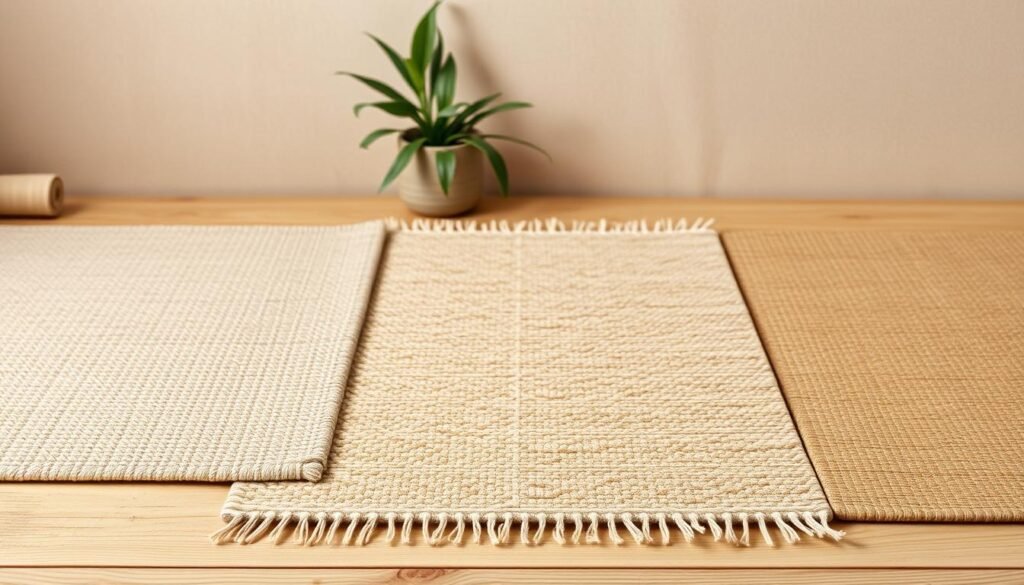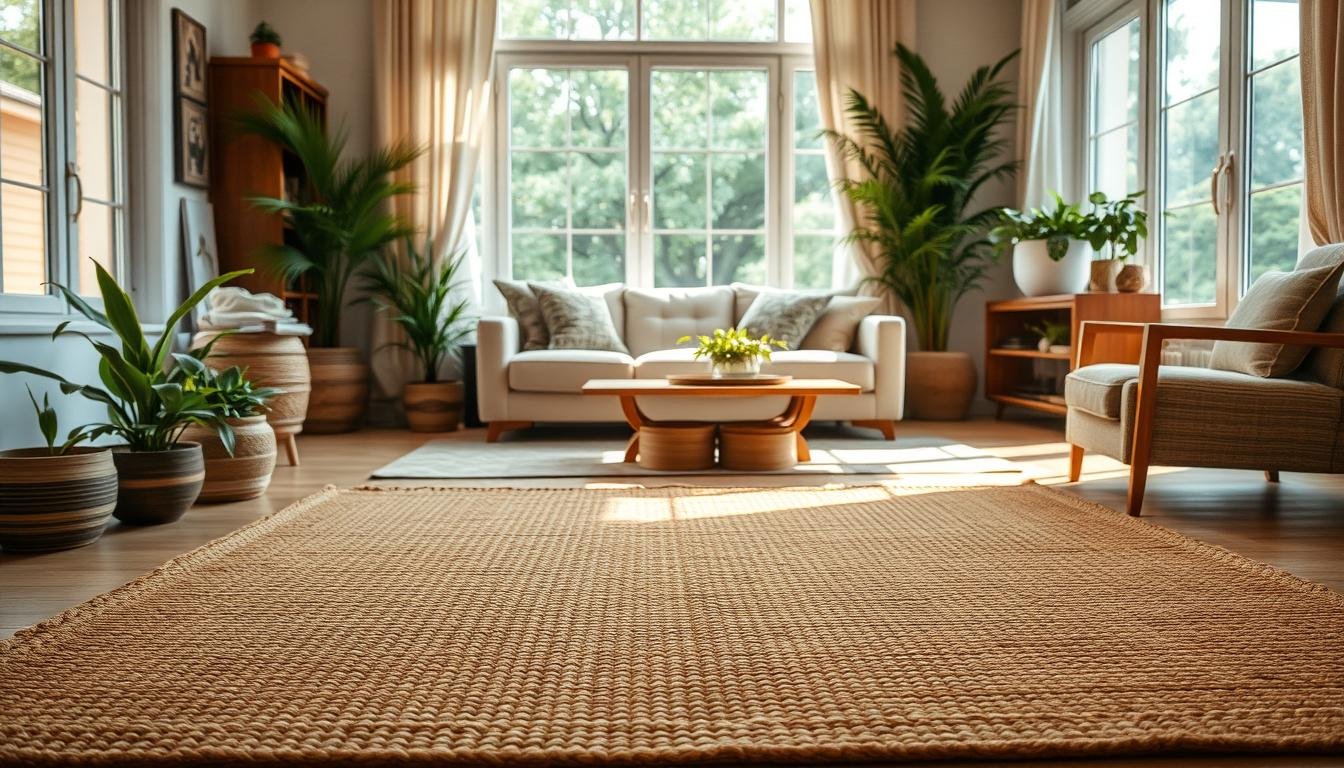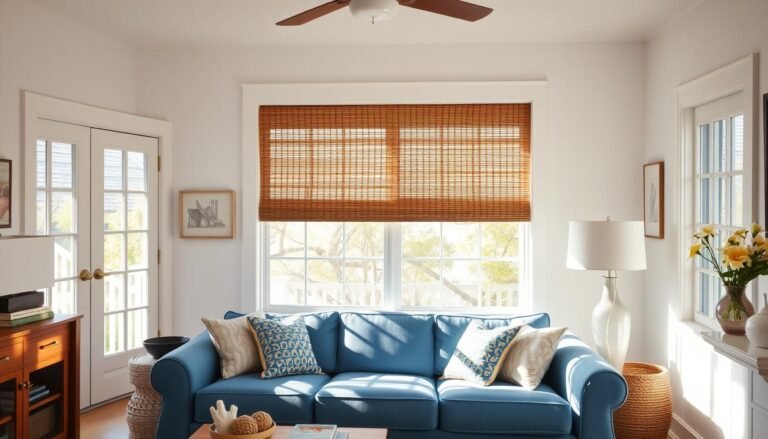As we look for green living options, a big question pops up: Can bamboo rugs last long? These rugs are loved for being eco-friendly and having a shiny look. Bamboo silk rugs are a hit with those who care about the planet.
Bamboo rugs are made from bamboo fibers turned into soft yarn. They add a touch of class to any space. But, are they really durable? Let’s dive into the good and bad sides of bamboo rugs, including their lasting power, cost, and how to keep them in top shape.
Key Takeaways
- Eco-friendly and sustainable alternative to traditional rugs
- Bamboo silk rugs offer a luxurious sheen and soft texture
- Durability depends on the quality of bamboo fibers and maintenance
- Price ranges vary based on size, quality, and brand
- Proper care is essential to extend the lifespan of bamboo rugs
What Are Bamboo Rugs?
Bamboo rugs are a mix of green, tough, and chic. They’re made from bamboo fibers, which look like silk. This makes them a great choice for homes.
Composition and Production Process
Making bamboo rugs starts with cutting bamboo. Bamboo grows fast and needs little care. It’s then turned into fibers and yarn.
This yarn is woven into rugs. These rugs are strong and can fit many styles. They’re also good for the planet because they use bamboo, a green crop.
Types of Bamboo Rugs Available
Bamboo rugs come in many styles. They fit different tastes and decor needs. Here are a few:
- Bamboo Silk Rugs: These rugs have a silky look and feel. They’re made from bamboo fibers turned into viscose.
- Natural Bamboo Rugs: These rugs keep bamboo’s natural look and feel. They offer a rustic, earthy vibe.
- Stained Bamboo Rugs: These rugs come in many colors. They’re stained to fit various home styles.
| Type of Bamboo Rug | Description | Key Features |
|---|---|---|
| Bamboo Silk Rugs | Made from bamboo fibers processed into viscose | Luxurious sheen, soft texture |
| Natural Bamboo Rugs | Retain natural texture and color of bamboo | Rustic appeal, eco-friendly |
| Stained Bamboo Rugs | Stained to match various interior designs | Colorful, versatile |
Benefits of Bamboo Rugs
Bamboo rugs are great for many reasons. They are good for the planet, look beautiful, and are healthy for us.
Eco-Friendliness and Sustainability
Bamboo grows fast, uses little water, and doesn’t need harmful chemicals. This makes bamboo rugs a eco-friendly and sustainable option. By picking bamboo rugs, we help the environment.
- Bamboo grows up to 3 feet per day, making it a highly renewable resource.
- It requires minimal water and no pesticides, reducing its environmental footprint.
- Bamboo absorbs more carbon dioxide and produces more oxygen than many other plants.
Natural Aesthetic Appeal
Bamboo rugs add a natural, warm feel to any room. Their texture and colors make spaces unique. Bamboo fits many design styles, from modern to traditional.
The natural aesthetic appeal of bamboo rugs is key. They make rooms feel cozy and organic.
Hypoallergenic Properties
Bamboo rugs are hypoallergenic. They fight dust mites and other allergens, making them safe for allergy sufferers. Bamboo fibers keep air inside our homes clean.
Choosing bamboo rugs improves our home’s look and health. They make our indoor air better.
Drawbacks of Bamboo Rugs
Bamboo rugs have many benefits, but they also have some downsides. It’s important to think about these drawbacks before choosing bamboo rugs for your home.
Susceptibility to Water Damage
Bamboo rugs are very sensitive to water. This can cause damage from spills or too much moisture. They might not be the best for wet areas like bathrooms or kitchens.
Key issues with water damage include:
- Discoloration: Water can change the bamboo’s color, affecting the rug’s look.
- Warping: Too much moisture can make the bamboo fibers warp or buckle.
- Mold and mildew: Long exposure to water can lead to mold and mildew growth.
Maintenance Challenges
Keeping bamboo rugs clean can be tough. They need regular cleaning and are careful about cleaning products. This makes their upkeep more complicated.
| Maintenance Task | Description | Frequency |
|---|---|---|
| Vacuuming | Gentle vacuuming to remove dust and debris | Weekly |
| Spot Cleaning | Immediate cleaning of spills using appropriate products | As needed |
| Deep Cleaning | Professional cleaning or deep cleaning methods | Quarterly |
Limited Color Options
Bamboo rugs have fewer color choices than synthetic or other natural fiber rugs. This can make it hard to find a bamboo rug that matches your color scheme or decor.
We know these drawbacks are important to consider when choosing bamboo rugs. Thinking about these points can help you make a better choice for your home.
Durability of Bamboo Rugs
Bamboo rugs are a great choice for those who want sustainable home decor. They last a good amount of time and can handle wear and tear well. Let’s see how they compare to other materials.
Lifespan Compared to Other Materials
Bamboo rugs are stylish and eco-friendly, but how long do they last? They are not as long-lasting as wool or synthetic fibers. Bamboo silk rugs, for example, are less durable and are best for low-traffic spaces.
A well-cared-for bamboo rug can last 5 to 10 years. This depends on the rug’s quality and how it’s used.

Resistance to Wear and Tear
Bamboo rugs are moderately resistant to wear and tear. They are not as tough as some materials but can last a long time with the right care. Regular vacuuming and spot cleaning can help them last longer.
They might not be the best for busy homes or places with pets and kids. To keep a bamboo rug looking good, follow the care instructions and place it wisely in your home.
Price Ranges for Bamboo Rugs
Bamboo rugs vary in price, from affordable to luxurious. The cost depends on the bamboo quality, craftsmanship, and design complexity.
Budget-Friendly Options
Looking for something affordable? Bamboo rugs with simpler designs and lower-grade bamboo are available. They’re eco-friendly and add natural beauty to your space.
- Price Range: $50-$200
- Characteristics: Simple designs, lower-grade bamboo
Mid-Range Choices
Mid-range bamboo rugs strike a balance between quality and price. They use better bamboo and may have more detailed designs. Perfect for most homes, they’re durable and stylish.
- Price Range: $200-$500
- Characteristics: Better-grade bamboo, varied designs
Luxury Bamboo Rugs
Luxury bamboo rugs are made from top-quality bamboo and feature complex designs. They’re not just rugs but also art pieces, adding elegance to any room.
- Price Range: $500-$1,500+
- Characteristics: High-quality bamboo, intricacy, traditional craftsmanship
Here’s a table to help you understand bamboo rug prices and features:
| Category | Price Range | Characteristics |
|---|---|---|
| Budget-Friendly | $50-$200 | Simple designs, lower-grade bamboo |
| Mid-Range | $200-$500 | Better-grade bamboo, varied designs |
| Luxury | $500-$1,500+ | High-quality bamboo, detailed designs, traditional craftsmanship |
When picking a bamboo rug, think about more than just the price. Consider quality, durability, and how it matches your decor. Whether you want something affordable or a luxury piece, there’s a bamboo rug for you.
Comparison with Similar Materials
Bamboo rugs are becoming more popular. But how do they compare to other rug materials? Knowing the differences between bamboo, cotton, polyester, and wood rugs helps us choose better.
Cotton Rugs vs. Bamboo Rugs
Cotton rugs are soft and comfy. But they’re not as durable or sustainable as bamboo rugs. Bamboo rugs are made from renewable bamboo and have a unique shine and softness.
- Bamboo Rugs: More durable and eco-friendly.
- Cotton Rugs: Softer but less sustainable.
Polyester Rugs vs. Bamboo Rugs
Polyester rugs are good at resisting stains and are affordable. But bamboo rugs have a natural beauty that polyester can’t match. Plus, bamboo rugs are biodegradable, making them better for the environment.
- Bamboo Rugs: Biodegradable and naturally beautiful.
- Polyester Rugs: Stain-resistant but not eco-friendly.
Wood Rugs vs. Bamboo Rugs
Wood rugs add elegance but can be heavy and pricey. Bamboo rugs offer a similar natural look at a lower cost. They’re also lighter and easier to care for than wood rugs.
- Bamboo Rugs: Lighter and potentially more cost-effective.
- Wood Rugs: Elegant but heavy and expensive.
In summary, bamboo rugs stand out for their sustainability, durability, and beauty. They’re a great choice for those looking for an eco-friendly option or a more affordable alternative to wood rugs.

Care and Maintenance Tips for Bamboo Rugs
Proper care and maintenance are key to keeping your bamboo rug in top shape. Bamboo rugs are durable and eco-friendly. But, they need regular care to stay looking great.
Cleaning Guidelines
Cleaning your bamboo rug often is important to stop dirt from building up. Here’s how to do it:
- Vacuum your bamboo rug weekly to get rid of dust and dirt.
- For spills, dab the area right away with a clean, dry cloth. Don’t rub it, as it can harm the bamboo fibers.
- For tough stains, mix a little mild detergent with water. Put the solution on the stain, gently scrub, and then blot it dry.
Stay away from harsh chemicals or too much water. They can harm the bamboo or make it lose its natural color.
Repairing and Restoring
As time goes by, your bamboo rug might show wear and tear. Here’s how to fix and restore it:
| Issue | Solution |
|---|---|
| Loose or broken slats | Reattach or replace the slats using bamboo adhesive or a small nail. |
| Discoloration | Use a bamboo-specific cleaner or a mix of equal parts water and white vinegar to bring back the color. |
Storage Recommendations
If you have to store your bamboo rug, follow these tips to avoid damage:
- Clean the rug well before storing it.
- Roll the rug instead of folding it to avoid creases and cracks.
- Store the rug in a dry, well-ventilated spot away from direct sunlight.
- Think about wrapping the rug in a breathable cloth to keep it dust-free.
By following these care and maintenance tips, you can enjoy your bamboo rug for a long time. It will stay beautiful and durable.
Pros and Cons of Bamboo Rugs
Exploring bamboo rugs’ advantages and disadvantages helps us see their value in sustainable living. These rugs are popular among those who care about the environment. They are known for being eco-friendly.
Advantages of Bamboo Rugs
Bamboo rugs have many benefits for homeowners. Here are some key advantages:
- Eco-friendliness and sustainability: Bamboo grows quickly and needs little water and pesticides.
- Natural aesthetic appeal: They bring a natural beauty to any room.
- Hypoallergenic properties: Bamboo rugs are good for people with allergies because they resist dust mites.
Bamboo rugs are also durable and can last a long time with the right care. They’re easy to clean with a damp cloth.
Disadvantages of Bamboo Rugs
Despite their benefits, bamboo rugs have some drawbacks. Here are the main disadvantages:
- Susceptibility to water damage: They can get damaged by too much moisture.
- Limited color options: Bamboo rugs usually come in natural colors, which can limit design choices.
- Potential for scratches and dents: Like any natural material, they can get scratched or dented if not cared for.
To understand bamboo rugs better, we’ve made a table with key points:
| Feature | Advantages | Disadvantages |
|---|---|---|
| Eco-friendliness | Bamboo is a highly renewable resource | May require special care to maintain eco-friendliness |
| Durability | Can last for many years with proper care | Susceptible to water damage and scratches |
| Aesthetic Appeal | Natural beauty adds warmth to any room | Limited color options |
Frequently Asked Questions (FAQs)
Exploring bamboo rugs brings up many questions. We’ll answer some common ones to help you decide.
Suitability for High-Traffic Areas
Bamboo rugs are good for many rooms. But, they might not be the best for places with lots of foot traffic. Bamboo silk rugs, for example, are too delicate for such areas.
Indoor Air Quality
Bamboo rugs are eco-friendly, which helps improve indoor air quality. They don’t release harmful chemicals like synthetic materials do. This makes them a healthier option for your home.
Use in Damp Environments
It’s not wise to use bamboo rugs in damp places. They can get damaged by water. Taking good care of your bamboo rug is key to keeping it lasting longer.
Knowing what bamboo rugs need helps you enjoy their beauty and benefits. This way, you can keep your living space healthy and sustainable.
FAQ
Are bamboo rugs suitable for high-traffic areas?
Yes, bamboo rugs work well in busy areas because they’re durable. They resist wear and tear well. But, pick a high-quality rug and take care of it properly.
How do bamboo rugs compare in terms of indoor air quality?
Bamboo rugs are great for air quality because they’re natural and eco-friendly. They don’t hold dust and allergens like synthetic rugs do. This makes them a healthier choice for homes.
Can bamboo rugs be used in damp environments?
No, bamboo rugs shouldn’t be in damp places. They can get damaged by water. Too much moisture can make the bamboo warp or grow mold.
Are bamboo rugs eco-friendly?
Yes, bamboo rugs are eco-friendly. Bamboo grows fast and needs little water and pesticides. This makes bamboo a green choice.
How do I clean and maintain my bamboo rug?
To keep your bamboo rug clean, vacuum often and clean spills right away. Don’t use strong chemicals or too much water. For deeper cleaning, use a mild soap and dry it well.
Can I use a bamboo rug in a kitchen or bathroom?
No, it’s not a good idea to use a bamboo rug in kitchens or bathrooms. These places are too wet. Bamboo can get damaged by too much water and humidity.
Are bamboo rugs durable?
Yes, bamboo rugs are pretty durable. They can handle some wear and tear. But, how long they last depends on the rug’s quality, care, and how much it’s walked on.
Can I stain or refinish a bamboo rug?
No, don’t stain or refinish a bamboo rug. It can harm the material and ruin its eco-friendly benefits. If you want to change its look, talk to a professional.




